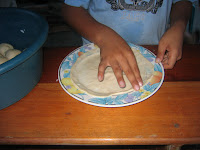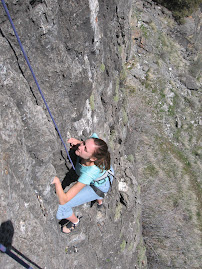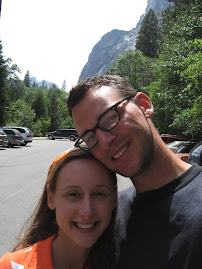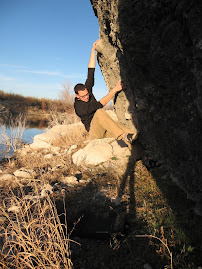 That's right. Kroppf's Bakery, Belize: absolutely the best chocolate chip cookies we've ever tasted. So far in training, Scott has lost 12 pounds, and I've lost 7. About the cookies, we don't know if this is our conclusion simply because we're hungry, or because they are truly light, crispy yet slightly chewy, cinnamon-y sweet morsels of perfection. No offense, Mom.
That's right. Kroppf's Bakery, Belize: absolutely the best chocolate chip cookies we've ever tasted. So far in training, Scott has lost 12 pounds, and I've lost 7. About the cookies, we don't know if this is our conclusion simply because we're hungry, or because they are truly light, crispy yet slightly chewy, cinnamon-y sweet morsels of perfection. No offense, Mom.
Thursday, October 16, 2008
The BEST Chocolate Chip Cookie Ever!!!
 That's right. Kroppf's Bakery, Belize: absolutely the best chocolate chip cookies we've ever tasted. So far in training, Scott has lost 12 pounds, and I've lost 7. About the cookies, we don't know if this is our conclusion simply because we're hungry, or because they are truly light, crispy yet slightly chewy, cinnamon-y sweet morsels of perfection. No offense, Mom.
That's right. Kroppf's Bakery, Belize: absolutely the best chocolate chip cookies we've ever tasted. So far in training, Scott has lost 12 pounds, and I've lost 7. About the cookies, we don't know if this is our conclusion simply because we're hungry, or because they are truly light, crispy yet slightly chewy, cinnamon-y sweet morsels of perfection. No offense, Mom.
Friday, October 10, 2008
Muy Amable





Meet our new host family! Demetrio y Ruth Soto, y Brian, Ronald, Ludin, y Keylin. They are so sweet and caring. They have been hosting our fellow trainee Alejandro and are graciously accepting us for a couple of months after he moves to nearby Trio. They are from Guatemala. These pictures are from dinner preparations one night during which Ruth taught us to make tortillas, Scott cut chicken from the bone for fajitas, and I taught Ruth to bake peanut butter cookies. It was exhausting and hot, but a lot of fun.
Friday, October 3, 2008
Which Brazil?

These are our Brazilian friends, Denise and Bruno. As part of a different humanitarian organization, they are living in Bella Vista for 4 months and are involved currently with health projects similar to what we hope to have. They also travel to several communities near the banana farms, promote HIV/AIDS prevention, teach English classes, and lead meetings about organic gardening in this area. They hope the gardens families begin to plant in Bella Vista will not only improve nutritional intake, but benefit budgets as well. With the price of food similar to America, it is nearly impossible to make ends meet on the amount of money a person makes working on the farms. Most workers make $2.50 an hour, which is $1.25 US.
A gardening resource for Peace Corps Volunteers is a book called How to Grow More Vegetables and is a result of the research and practices of an organization based in California called Ecology Action and its program GROW BIOINTENSIVE. They propose working toward sustainability by returning to small-scale farming to meet each person’s caloric needs, taking care in turn to grow crops in a way that replenishes nutrients in the soil up to 99%. The GROW BIOINTENSIVE mini-farm model is proportioned as 60% grains and other high-carbon crops, 30% high-calorie root crops, and 10% vegetable crops (Jeavons 28). A percentage of the vegetable crops can be grown as income crops. A living project called Biosphere II, which used Ecology Action agricultural techniques, proved that a complete year’s diet for one person could be raised on the equivalent of 3,403 square feet (Jeavons 30). By contrast, commercial agriculture uses 15,000 to 30,000 square feet to produce all the food for one person for one year, 16,000 in the developing world. These Biointensive methods are used as nutrition intervention in Mexico and are spreading throughout Latin America.
We hope to build on the interest in family gardens here in the coming months.
Jeavons, John. How to Grow More Vegetables* (and fruits, nuts, berries, grains, and other crops) *than you ever thought possible on less land than you can imagine: A Primer on the Life-Giving Sustainable GROW BIOINTENSIVE Method of Organic Horticulture. Ecology Action of the Midpeninsula. Willits, California: 2002.
http://www.growbiointensive.org/
A gardening resource for Peace Corps Volunteers is a book called How to Grow More Vegetables and is a result of the research and practices of an organization based in California called Ecology Action and its program GROW BIOINTENSIVE. They propose working toward sustainability by returning to small-scale farming to meet each person’s caloric needs, taking care in turn to grow crops in a way that replenishes nutrients in the soil up to 99%. The GROW BIOINTENSIVE mini-farm model is proportioned as 60% grains and other high-carbon crops, 30% high-calorie root crops, and 10% vegetable crops (Jeavons 28). A percentage of the vegetable crops can be grown as income crops. A living project called Biosphere II, which used Ecology Action agricultural techniques, proved that a complete year’s diet for one person could be raised on the equivalent of 3,403 square feet (Jeavons 30). By contrast, commercial agriculture uses 15,000 to 30,000 square feet to produce all the food for one person for one year, 16,000 in the developing world. These Biointensive methods are used as nutrition intervention in Mexico and are spreading throughout Latin America.
We hope to build on the interest in family gardens here in the coming months.
Jeavons, John. How to Grow More Vegetables* (and fruits, nuts, berries, grains, and other crops) *than you ever thought possible on less land than you can imagine: A Primer on the Life-Giving Sustainable GROW BIOINTENSIVE Method of Organic Horticulture. Ecology Action of the Midpeninsula. Willits, California: 2002.
http://www.growbiointensive.org/
Subscribe to:
Posts (Atom)








